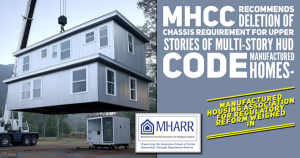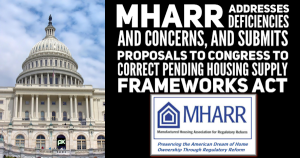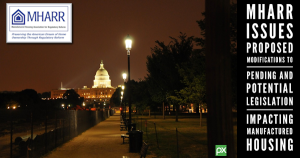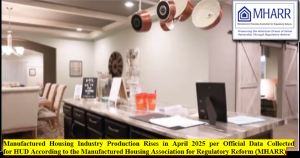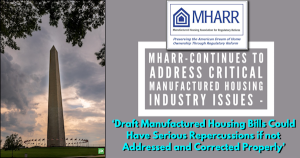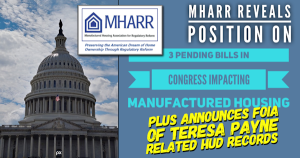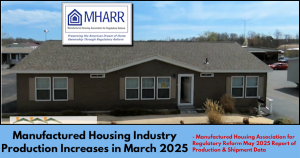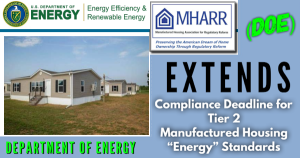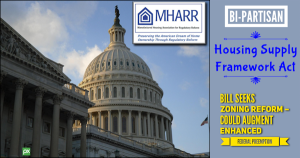President Trump’s Regulatory Order Obliterates Excuses By HUD, FHFA, FANNIE MAE, FREDDIE MAC, GNMA AND DOE
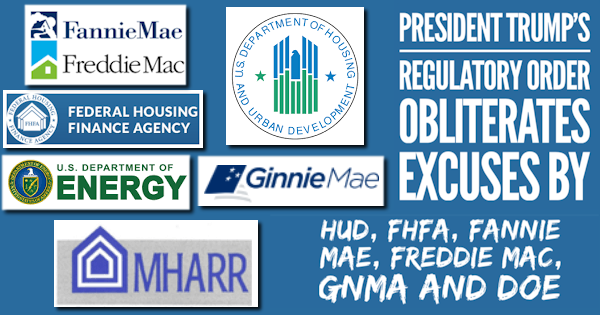
Washington, D.C., May 20, 2020 – The Manufactured Housing Association for Regulatory Reform (MHARR) – an industry group representing small businesses in the federally-regulated factory-built housing industry — reports that in his most recent Executive Order (EO) targeting regulatory reform within the federal government, President Trump has directed Executive Branch federal agencies to address and help remedy the “economic emergency” created by the current COVID-19 pandemic by “rescinding, modifying, waiving or providing exemptions from regulations and other requirements that may inhibit economic recovery….” (Emphasis added).
Specifically, the May 19, 2020 Order instructs the “heads of all agencies” to “identify regulatory standards that may inhibit economic recovery and shall consider taking appropriate action … including by issuing proposed rules as necessary, to temporarily or permanently rescind, modify, waive, or exempt persons or entities from those requirements, and to consider exercising appropriate temporary enforcement discretion … for the purpose of promoting job creation and economic growth….” The May 19, 2020 EO thus adds an exclamation point to – and underscores the urgency of – the completion and full implementation of the regulatory reform processes initiated by President Trump under Executive Orders 13771, 13777, 13891 and 13892, beginning in 2017.
Indeed, this decisive regulatory reform Executive Order by President Trump, could not have come soon enough for the federally-regulated manufactured housing industry, which has had its production and sales artificially and unnecessarily suppressed for years – even before the COVID-19 pandemic – by a combination of needless federal regulation and higher-rate, arguably “predatory”-level lending driven by a near-complete lack of support for the manufactured housing consumer financing market by the federally-supported mortgage giants, Fannie Mae and Freddie Mac. These factors have kept the production of quality, affordable manufactured homes (i.e., the most affordable source of quality non-subsidized homeownership for moderate and lower-income American families according to HUD-sponsored research) suppressed well below the hundreds of thousands of homes per year that would otherwise be expected in the middle of an extended affordable housing crisis.
Most importantly, then, for the manufactured housing industry and for American consumers of affordable housing, the President’s latest mandate for immediate federal regulatory reform to rapidly restore the national economy in the wake of the COVID-19 pandemic — and, in particular, to jump-start the production of goods and services by smaller businesses disproportionally-impacted by the pandemic – can, should and must put an end to the baseless delays and stonewalling that thus far have needlessly thwarted the adoption, implementation and resolution of much-needed regulatory reforms affecting manufactured housing, including reforms mandated by existing federal laws.
This stonewalling reaches across multiple federal agencies (including the U.S. Department of Housing and Urban Development – “HUD;” the U.S. Department of Energy – “DOE;” and the Federal Housing Finance Agency – “FHFA;” and the Government National Mortgage Association – “GNMA” or “Ginnie Mae,” among others) and affects key aspects of the manufactured housing market in ways that have unlawfully deprived lower and moderate-income American families of access to the nation’s most affordable source of inherently-affordable, non-subsidized homeownership, while simultaneously and artificially stifling the production of federally-regulated manufactured housing which has spent the past decade-plus at annual levels far below historic norms.
Each and every one of these matters should have already been addressed by the relevant agencies under the Executive Orders previously issued by President Trump. With the adoption of the May 19, 2020 EO, however, it is now abundantly clear that these agencies have an affirmative obligation to take immediate action to implement the systemic regulatory reforms mandated by the Administration. Therefore, the following pending but incomplete regulatory reform actions must be undertaken without delay, in order to ensure not only the rapid recovery of the national economy in the wake of the COVID-19 pandemic, but also the short and long-term availability of modern, quality, affordable, mainstream manufactured housing for lower and moderate-income American families:
U.S. Department of Housing and Urban Development: HUD must complete and immediately implement its pending “top-to-bottom” review of all HUD manufactured housing standards and regulations. That process, first initiated in 2017, has already taken far too long and has left in place numerous provisions that needlessly inflate the cost of manufactured housing to American consumers and needlessly increase the regulatory compliance costs and burdens borne by manufacturers, while providing little or no corresponding benefits for consumers. Certain of these provisions, moreover, as repeatedly emphasized by MHARR and HUD’s own Manufactured Housing Consensus Committee (MHCC), either exceed or are inconsistent with their supposed statutory predicates. Thus, HUD, prior to the end of 2020, and in accordance with President Trump’s May 19, 2020 EO, must, at a minimum –
- Withdraw its February 2010 “Interpretive Rule” which unlawfully negates section 604(b)(6) of the 2000 reform law;
- Adopt MHCC-recommended revisions to Subpart I of its manufactured housing Procedural and Enforcement Regulations (24 C.F.R. 3282), the primary driver of inflated regulatory compliance costs within the HUD regulatory program, and the primary enabler of excessive and unlawful in-plant enforcement activity by HUD and HUD contractors;
- Complete action to adopt and implement each of the regulatory reform recommendations approved and submitted by the MHCC in 2019;
- Take action to federally preempt or otherwise invalidate local zoning or placement mandates which discriminatorily exclude or restrict the placement of federally-regulated manufactured homes; and
- In accordance with EOs 13891 and 13892, take specific action to expressly withdraw each and every so-called manufactured housing “guidance” document issued by HUD without notice and comment rulemaking as required by federal law since 1974 and without prior MHCC review and recommendation, as required by federal law since 2000 (including its baseless expansion of in-plant regulation).
These actions, moreover, represent the minimum that HUD should and must do to restore and advance mainstream manufactured housing and the availability of affordable homeownership for American families.
FHFA, Fannie Mae and Freddie Mac: These organizations continue to defy Congress and the specific DTS statutory mandate with respect to manufactured housing some 12 years after DTS’ enactment. This failure continues to cause substantial harm to all segments of the manufactured housing market – and to American consumers of affordable housing – that has now been compounded and exacerbated by the economic dislocation resulting from the COVID-19 pandemic and related closures. Harm to consumers includes, but is not limited to –
- The exclusion of large numbers of consumers from the manufactured housing market (and from any type of homeownership) altogether due to higher-than-necessary interest rates for manufactured home loans resulting from the absence of securitization or secondary-market support for manufactured home loans (and particularly manufactured home personal property loans); and
- The large number of consumers that are unnecessarily forced – by the same absence of securitization or secondary market support – to pay higher-interest and potentially “predatory” interest rates on manufactured housing loans.
This, in turn, harms the industry – and particularly its smaller businesses (including smaller manufacturers that do not have captive finance companies) — by artificially limiting and constraining the size of the market, as millions of otherwise qualified potential purchasers are excluded or eliminated from the market. Consistent with President Trump’s May 19, 2020 EO, therefore, FHFA should be compelled to end its diversion and delay of DTS and fully implement that mandate, in a market-significant manner, with respect to the entire mainstream, HUD Code manufactured housing market, including, but not limited to, manufactured housing personal property loans.
GNMA: The Federal Housing Administration’s (FHA) Title I program, at one time, was a significant source of affordable financing for federally-regulated manufactured homes. Since the adoption of the so-called “10-10” rule by GNMA, however (requiring authorized lenders to have a minimum $10 million net worth and maintain a minimum reserve equal to ten percent of all outstanding manufactured housing mortgage-backed securities), support for manufactured home purchase lending under the Title I program has fallen to negligible levels (if any), thus effectively depriving consumers of an alternate source of financing to the higher-interest lenders that predominate within the mainstream, HUD Code manufactured housing market. This – like the failure of FHFA, Fannie Mae and Freddie Mac to fully and properly implement DTS – has caused significant harm to both the HUD Code manufactured housing industry (and particularly its smaller businesses), as well as consumers of affordable housing. This highly restrictive and damaging policy (in effect for approximately a decade), moreover, has never been publicly qualified by GNMA or, to MHARR’s knowledge or information, subsequently revisited by GNMA based on more recent and/or relevant information. Consequently, based on President Trump’s May 19, 2020 EO, GNMA should revisit, re-examine and either withdraw or substantially modify it current 10-10 rule to provide for the approval of a market-significant number of new, mainstream, HUD Code manufactured housing issuers.
U.S. Department of Energy: DOE manufactured housing energy regulation is not only unnecessary, as demonstrated by U.S. Census Bureau energy cost data, and discriminatory against lower and moderate-income consumers, but – as fully documented by MHARR time and again in written comments — has been consistently plagued by tainted, illegitimate and arguably unlawful procedures over the entire course of its prior development. These factors have led the Office of Management and Budget (OMB) to reject proposed DOE manufactured housing energy standards not once, but twice. As MHARR has consistently demonstrated, DOE energy standards for manufactured homes (which are already comprehensively federally-regulated by HUD) are not only unnecessary, but would impose nearly-impossible additional cost burdens on consumers. Those cost burdens would include major increases in the purchase cost of manufactured homes (up to $6,000 for a double-section home as estimated by MHARR), as well as additional costs for testing and regulatory compliance which have never even been estimated or examined by DOE, all of which would place manufactured housing beyond the means of millions more Americans without any significant or even discernable corresponding benefit. The industry, moreover, with such extreme potential cost burdens looming as a threat for more than a decade, cannot fully and accurately assess the cost burdens and potential risks and returns related to investments in energy-related matters that could, in fact, further enhance the affordability of manufactured homes. Accordingly, based on EOs 13771 and 13777, as well as President Trump’s May 19, 2020 EO, this destructive pending manufactured housing regulation should be withdrawn permanently, with further action deferred indefinitely.
While the foregoing list of essential regulatory reform actions is by no means exhaustive, the items noted above are the most significant actions that can and must be taken at the federal level to help break decades of gridlock, restore and expand the manufactured housing market and enhance the supply and availability of truly affordable housing and homeownership as required by law. Accordingly, the entire industry must press for action by each such organization on all of these fronts, in accordance with the May 19, 2020 EO in order to rapidly restore and expand the availability of inherently affordable manufactured housing.
In Washington, D.C., MHARR President and CEO, Mark Weiss, stated: “Once again, President Trump, with his May 19, 2020 regulatory reform Executive Order, has proven that he stands behind small American businesses – such as those within the federally-regulated manufactured housing industry – that are the engines of American housing innovation, economic expansion and job growth. These are critical times and the entire industry must stop the generalizations and self-congratulations, and instead focus like a laser-beam on the resolution of the above matters, which would help catapult the industry to production levels that are consistent with known demand.”
The Manufactured Housing Association for Regulatory Reform is a Washington, D.C.-based national trade association representing the views and interests of independent producers of federally-regulated manufactured housing.

Washington, D.C., May 20, 2020 – The Manufactured Housing Association for Regulatory Reform (MHARR) – an industry group representing small businesses in the federally-regulated factory-built housing industry — reports that in his most recent Executive Order (EO) targeting regulatory reform within the federal government, President Trump has directed Executive Branch federal agencies to address and help remedy the “economic emergency” created by the current COVID-19 pandemic by “rescinding, modifying, waiving or providing exemptions from regulations and other requirements that may inhibit economic recovery….” (Emphasis added).
Specifically, the May 19, 2020 Order instructs the “heads of all agencies” to “identify regulatory standards that may inhibit economic recovery and shall consider taking appropriate action … including by issuing proposed rules as necessary, to temporarily or permanently rescind, modify, waive, or exempt persons or entities from those requirements, and to consider exercising appropriate temporary enforcement discretion … for the purpose of promoting job creation and economic growth….” The May 19, 2020 EO thus adds an exclamation point to – and underscores the urgency of – the completion and full implementation of the regulatory reform processes initiated by President Trump under Executive Orders 13771, 13777, 13891 and 13892, beginning in 2017.
Indeed, this decisive regulatory reform Executive Order by President Trump, could not have come soon enough for the federally-regulated manufactured housing industry, which has had its production and sales artificially and unnecessarily suppressed for years – even before the COVID-19 pandemic – by a combination of needless federal regulation and higher-rate, arguably “predatory”-level lending driven by a near-complete lack of support for the manufactured housing consumer financing market by the federally-supported mortgage giants, Fannie Mae and Freddie Mac. These factors have kept the production of quality, affordable manufactured homes (i.e., the most affordable source of quality non-subsidized homeownership for moderate and lower-income American families according to HUD-sponsored research) suppressed well below the hundreds of thousands of homes per year that would otherwise be expected in the middle of an extended affordable housing crisis.
Most importantly, then, for the manufactured housing industry and for American consumers of affordable housing, the President’s latest mandate for immediate federal regulatory reform to rapidly restore the national economy in the wake of the COVID-19 pandemic — and, in particular, to jump-start the production of goods and services by smaller businesses disproportionally-impacted by the pandemic – can, should and must put an end to the baseless delays and stonewalling that thus far have needlessly thwarted the adoption, implementation and resolution of much-needed regulatory reforms affecting manufactured housing, including reforms mandated by existing federal laws.
This stonewalling reaches across multiple federal agencies (including the U.S. Department of Housing and Urban Development – “HUD;” the U.S. Department of Energy – “DOE;” and the Federal Housing Finance Agency – “FHFA;” and the Government National Mortgage Association – “GNMA” or “Ginnie Mae,” among others) and affects key aspects of the manufactured housing market in ways that have unlawfully deprived lower and moderate-income American families of access to the nation’s most affordable source of inherently-affordable, non-subsidized homeownership, while simultaneously and artificially stifling the production of federally-regulated manufactured housing which has spent the past decade-plus at annual levels far below historic norms.
Each and every one of these matters should have already been addressed by the relevant agencies under the Executive Orders previously issued by President Trump. With the adoption of the May 19, 2020 EO, however, it is now abundantly clear that these agencies have an affirmative obligation to take immediate action to implement the systemic regulatory reforms mandated by the Administration. Therefore, the following pending but incomplete regulatory reform actions must be undertaken without delay, in order to ensure not only the rapid recovery of the national economy in the wake of the COVID-19 pandemic, but also the short and long-term availability of modern, quality, affordable, mainstream manufactured housing for lower and moderate-income American families:
U.S. Department of Housing and Urban Development: HUD must complete and immediately implement its pending “top-to-bottom” review of all HUD manufactured housing standards and regulations. That process, first initiated in 2017, has already taken far too long and has left in place numerous provisions that needlessly inflate the cost of manufactured housing to American consumers and needlessly increase the regulatory compliance costs and burdens borne by manufacturers, while providing little or no corresponding benefits for consumers. Certain of these provisions, moreover, as repeatedly emphasized by MHARR and HUD’s own Manufactured Housing Consensus Committee (MHCC), either exceed or are inconsistent with their supposed statutory predicates. Thus, HUD, prior to the end of 2020, and in accordance with President Trump’s May 19, 2020 EO, must, at a minimum –
- Withdraw its February 2010 “Interpretive Rule” which unlawfully negates section 604(b)(6) of the 2000 reform law;
- Adopt MHCC-recommended revisions to Subpart I of its manufactured housing Procedural and Enforcement Regulations (24 C.F.R. 3282), the primary driver of inflated regulatory compliance costs within the HUD regulatory program, and the primary enabler of excessive and unlawful in-plant enforcement activity by HUD and HUD contractors;
- Complete action to adopt and implement each of the regulatory reform recommendations approved and submitted by the MHCC in 2019;
- Take action to federally preempt or otherwise invalidate local zoning or placement mandates which discriminatorily exclude or restrict the placement of federally-regulated manufactured homes; and
- In accordance with EOs 13891 and 13892, take specific action to expressly withdraw each and every so-called manufactured housing “guidance” document issued by HUD without notice and comment rulemaking as required by federal law since 1974 and without prior MHCC review and recommendation, as required by federal law since 2000 (including its baseless expansion of in-plant regulation).
These actions, moreover, represent the minimum that HUD should and must do to restore and advance mainstream manufactured housing and the availability of affordable homeownership for American families.
FHFA, Fannie Mae and Freddie Mac: These organizations continue to defy Congress and the specific DTS statutory mandate with respect to manufactured housing some 12 years after DTS’ enactment. This failure continues to cause substantial harm to all segments of the manufactured housing market – and to American consumers of affordable housing – that has now been compounded and exacerbated by the economic dislocation resulting from the COVID-19 pandemic and related closures. Harm to consumers includes, but is not limited to –
- The exclusion of large numbers of consumers from the manufactured housing market (and from any type of homeownership) altogether due to higher-than-necessary interest rates for manufactured home loans resulting from the absence of securitization or secondary-market support for manufactured home loans (and particularly manufactured home personal property loans); and
- The large number of consumers that are unnecessarily forced – by the same absence of securitization or secondary market support – to pay higher-interest and potentially “predatory” interest rates on manufactured housing loans.
This, in turn, harms the industry – and particularly its smaller businesses (including smaller manufacturers that do not have captive finance companies) — by artificially limiting and constraining the size of the market, as millions of otherwise qualified potential purchasers are excluded or eliminated from the market. Consistent with President Trump’s May 19, 2020 EO, therefore, FHFA should be compelled to end its diversion and delay of DTS and fully implement that mandate, in a market-significant manner, with respect to the entire mainstream, HUD Code manufactured housing market, including, but not limited to, manufactured housing personal property loans.
GNMA: The Federal Housing Administration’s (FHA) Title I program, at one time, was a significant source of affordable financing for federally-regulated manufactured homes. Since the adoption of the so-called “10-10” rule by GNMA, however (requiring authorized lenders to have a minimum $10 million net worth and maintain a minimum reserve equal to ten percent of all outstanding manufactured housing mortgage-backed securities), support for manufactured home purchase lending under the Title I program has fallen to negligible levels (if any), thus effectively depriving consumers of an alternate source of financing to the higher-interest lenders that predominate within the mainstream, HUD Code manufactured housing market. This – like the failure of FHFA, Fannie Mae and Freddie Mac to fully and properly implement DTS – has caused significant harm to both the HUD Code manufactured housing industry (and particularly its smaller businesses), as well as consumers of affordable housing. This highly restrictive and damaging policy (in effect for approximately a decade), moreover, has never been publicly qualified by GNMA or, to MHARR’s knowledge or information, subsequently revisited by GNMA based on more recent and/or relevant information. Consequently, based on President Trump’s May 19, 2020 EO, GNMA should revisit, re-examine and either withdraw or substantially modify it current 10-10 rule to provide for the approval of a market-significant number of new, mainstream, HUD Code manufactured housing issuers.
U.S. Department of Energy: DOE manufactured housing energy regulation is not only unnecessary, as demonstrated by U.S. Census Bureau energy cost data, and discriminatory against lower and moderate-income consumers, but – as fully documented by MHARR time and again in written comments — has been consistently plagued by tainted, illegitimate and arguably unlawful procedures over the entire course of its prior development. These factors have led the Office of Management and Budget (OMB) to reject proposed DOE manufactured housing energy standards not once, but twice. As MHARR has consistently demonstrated, DOE energy standards for manufactured homes (which are already comprehensively federally-regulated by HUD) are not only unnecessary, but would impose nearly-impossible additional cost burdens on consumers. Those cost burdens would include major increases in the purchase cost of manufactured homes (up to $6,000 for a double-section home as estimated by MHARR), as well as additional costs for testing and regulatory compliance which have never even been estimated or examined by DOE, all of which would place manufactured housing beyond the means of millions more Americans without any significant or even discernable corresponding benefit. The industry, moreover, with such extreme potential cost burdens looming as a threat for more than a decade, cannot fully and accurately assess the cost burdens and potential risks and returns related to investments in energy-related matters that could, in fact, further enhance the affordability of manufactured homes. Accordingly, based on EOs 13771 and 13777, as well as President Trump’s May 19, 2020 EO, this destructive pending manufactured housing regulation should be withdrawn permanently, with further action deferred indefinitely.
While the foregoing list of essential regulatory reform actions is by no means exhaustive, the items noted above are the most significant actions that can and must be taken at the federal level to help break decades of gridlock, restore and expand the manufactured housing market and enhance the supply and availability of truly affordable housing and homeownership as required by law. Accordingly, the entire industry must press for action by each such organization on all of these fronts, in accordance with the May 19, 2020 EO in order to rapidly restore and expand the availability of inherently affordable manufactured housing.
In Washington, D.C., MHARR President and CEO, Mark Weiss, stated: “Once again, President Trump, with his May 19, 2020 regulatory reform Executive Order, has proven that he stands behind small American businesses – such as those within the federally-regulated manufactured housing industry – that are the engines of American housing innovation, economic expansion and job growth. These are critical times and the entire industry must stop the generalizations and self-congratulations, and instead focus like a laser-beam on the resolution of the above matters, which would help catapult the industry to production levels that are consistent with known demand.”
The Manufactured Housing Association for Regulatory Reform is a Washington, D.C.-based national trade association representing the views and interests of independent producers of federally-regulated manufactured housing.




